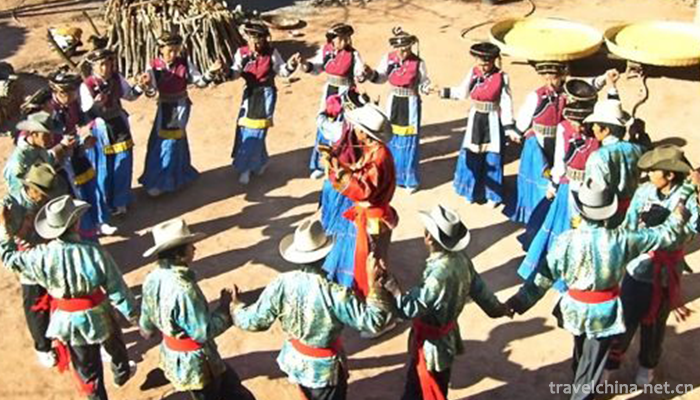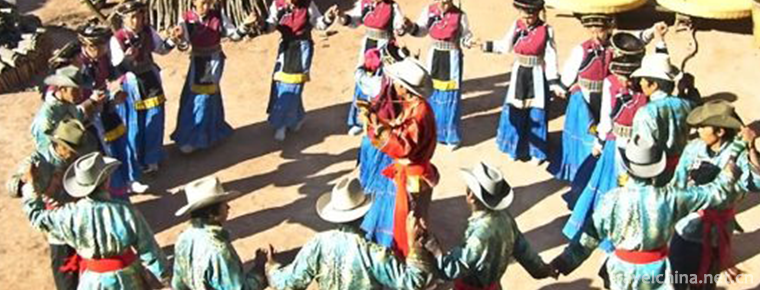Pumi rubbing
Pumi rubbing
Pumi nationality rubbing "rubbing consultation" is Pumi language, "rubbing" means dancing, "rubbing" means dancing, that is, dancing. When dancing, the leader strikes the sheepskin according to a certain rhythm, playing the effect of drumming, so it is also called "sheepskin dance". In addition, there is also the name of "four-string dance" or "Pumi Guozhuang". Mainly spread in Tongdian, Hexi, Lajing, Jinding and Shideng villages where Pumi people live together.
On June 7, 2006, "Pumi rubbing" declared by Lanping Bai Autonomous County of Yunnan Province was included in the second batch of national intangible cultural heritage list.
Heritage serial number: 675 III-78.
historical origin
The origin of "rubbing" can not be traced to history. Folklore tells us that in a war, the Pumi ancestors lit bonfires at night and danced "rubbing" all night long, which made the enemy mistake them for numerous people and horses, and eventually withdrew from the enemy. According to the old artists, the traditional "rubbing" dance has 72 tunes, i.e. 72 sets of changes in dance steps, but only 12 sets of "reunion dance", "bowl chopsticks dance", "similar dance", "shoe-sole dance", "arm-to-arm dance" and "end dance" remain.
artistic characteristics
artistic form
There are twelve sets of rubbing and negotiating dances, but after a long period of circulation, dancing steps have developed everywhere, and different dancing steps are increasing day by day. Nevertheless, there are many similarities and differences in expressive techniques, and the sound type and rhythm are basically fixed. This is a description of the twelve sets of dance steps in Longtang, Tongdian and Waterfront before the 1960s. Its main characteristics are: the force of stamping is vertical (focus on the forefoot of the center of gravity), the force of striding (walking) is horizontal (force point in the crotch), forward bending when regression, reverse upper and lower body strength, backward (natural) when upward and forward, reverse upper and lower body strength (force point in the abdomen position). The representative programs of vertical relationship are "Dengbu Langla" (one foot and two feet); the representative programs of horizontal relationship are "steep worship needs Xu Zhi" (hip-to-hip dance); and the representative programs of opposite force (upper and lower body) are the first dance method of "synthesize" (reunion dance).
The speed is generally medium. When the speed is slow, the dance steps are light and sprinkled, as if the breeze is rhythmically affecting the dress. When the speed increases, the dance steps are rough and powerful.
Formation, mainly (hand in hand) single circle, double circle and half circle, generally used to jump counterclockwise, but also clockwise. If a double circle is formed, jumps in the same direction and in different directions can be made. Dancing is not limited by time, place and number. People who participate in dancing can intervene at any time, or start one after another. Some people can dance and others can sing (folk songs) as they walk. After singing, they danced.
Artistic Characteristics
The "rubbing" dance retains the characteristics of the trinity of ancient songs, dances and music. It has a variety of names, varied formations and steps, with relaxation and relaxation. It is the Pumi people's favorite dance, widely spread, mostly used in various self-entertainment, festive fitness activities, not limited by the number of participants, few dozens of people participate, more than tens of thousands of people can dance together, to express national unity and joy, has a certain artistry.
Inheritance Significance
"Rubbing" is a happy folk dance symbolizing unity, friendship, auspiciousness and happiness. It is popular with the Pumi people and the surrounding ethnic groups, and has created a high reputation in China. Its basic contents and forms are as follows: accompanied by a four-string harp, a dancer taps the wrapped sheepskin in rhythm and produces rhythmic music accompanied by the change of dance steps. The artistic creation of "Dragon Opening Door", "Dragon Out of Water", "Dragon Turning over", "Dragon Drilling Hole", "Dragon Swinging Tail", "Dragon Holding Column", "Dragon Closing Door" and "Dragon Happiness" is twisted and twisted. Type I, team type changes quickly and smoothly, vigorous and lively, momentum, a thousand miles.


-
1.Three Gorges Household Scenic Area
Three Gorges Household Scenic Area, National AAAAA Class Tourist Area, the First Batch of Civilized Scenic Area in Hubei Province, Top Ten Scenic Spots in Hubei Province
Time 2018-12-12 -
2.Shanghai Museum
The Shanghai Museum was founded in 1952. It was originally located at the Old Jockey Club at 325 Nanjing West Road. It moved to the Zhonghui Building at 16 Henan South Road in October 1959
Time 2018-12-19 -
3.Bihai Jinsha Water Paradise
Bihai Jinsha Water Paradise (i.e. Coastal Recreation Park, abbreviated as "Water Paradise") is built outside the flood control wall, along the flood control wall 1313 meters
Time 2019-01-03 -
4.Jiangshan Peninsula Tourist Resort
Jiangshan Peninsula Tourist Resort is a provincial tourism resort development zone approved by the People's Government of Guangxi Zhuang Autonomous Region in 1994.
Time 2019-01-21 -
5.GA Da Meilin
Gadamelin (1892 - April 5, 1931), Mongolian, surname Molettu (translated into Chinese as Meng), Nadamud, Han name Meng Qingshan, also known as Yexi, Mongolian legendary hero. Born in Zhelimu League
Time 2019-04-30 -
6.Liu Sanjies Ballads
Liu Sanjie's folk songs, a local traditional folk literature in Yizhou City, Guangxi Zhuang Autonomous Region, are one of the national intangible cultural heritages.
Time 2019-05-13 -
7.Lusheng music
Lusheng is one of the core musical instruments in Miao traditional music culture. In the long history of Miao music practice, its cultural function is not limited to universal musical instruments, bec
Time 2019-05-15 -
8.Lacquerware Decoration Techniques
Chu-style lacquerware decoration is a traditional folk lacquerware decoration technique. By the Spring and Autumn Period and the Warring States Period, the production technology
Time 2019-06-10 -
9.Chizhou University
Chizhou college is Anhui Province Full time general Undergraduate Colleges It's the only one in China. Hui Style Architecture The style of colleges and universities is the only one in Anhui colleges a
Time 2019-11-09 -
10.Diexi earthquake site
Diexi earthquake site is located 2.5 km southeast of Jiaochang Township, Maoxian County, on the second grade platform on the East Bank of Minjiang River
Time 2020-11-07 -
11.Chinese Cheongsam QiPao start time
When it comes to the beginning of cheongsam fashion, it is generally believed that in the period of the Republic of China in the 20th century, Mr. Zheng Yimei said that "the original women wore short clothes in the Qing Dynasty, but did not wear
Time 2020-12-11 -
12.Deyang science and technology
In 2018, Deyang City won 141 provincial projects, including 108 provincial science and technology plan projects and 33 Provincial Intellectual property projects. There are 32 provincial patent implementation projects. 184 high-tech enterprises. A total of
Time 2020-12-14